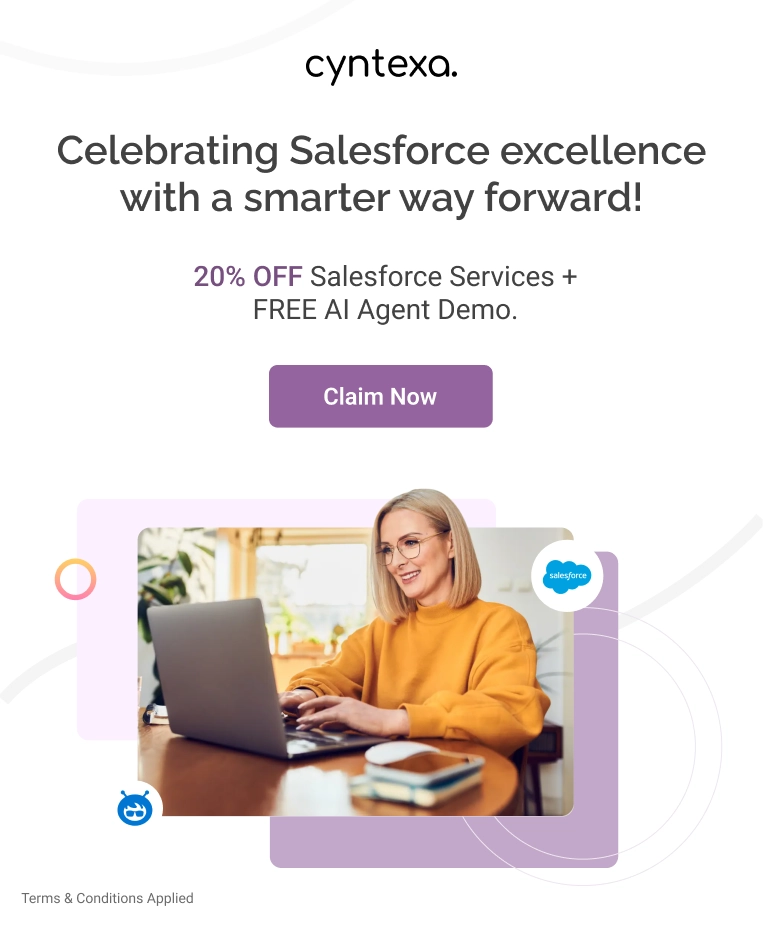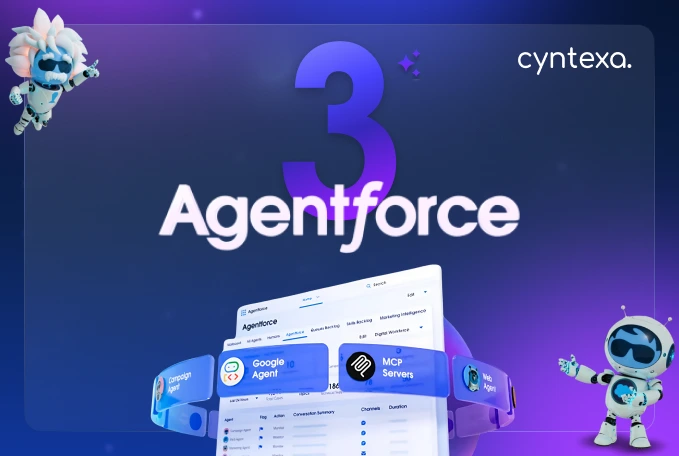Salesforce Unveils Agentforce 3: AI Command Center, Native MCP & Enterprise-Grade Atlas
Salesforce has officially unveiled Agentforce 3, the latest and most ambitious evolution of its digital labor platform, and perhaps its boldest answer yet to the complex realities of scaling AI agents in the enterprise.
Following a remarkable surge in adoption, with 8,000+ customers onboarded and AI agents usage up 233% in just six months, Salesforce is shifting the conversation from how to deploy AI agents to how to manage them responsibly at scale.
Agentforce 3 introduces a suite of powerful new capabilities:
- Real-time observability and performance monitoring
- Plug-and-play integrations with major platforms like AWS, Google, and Stripe
- Architectural upgrades for faster, smarter, more resilient AI operations
Early adopters have already seen significant impact:
- Engine cut case handling times by 15%
- 1-800Accountant resolved 70% of chats autonomously during peak tax season
- Grupo Globo increased subscriber retention by 22%
As AI agents take on more complex roles across industries, Agentforce 3 aims to give organizations not just more digital labor, but the tools to see, govern, and trust that labor as it scales.
Agentforce Command Center For Observability & Control
The core highlight of Agentforce 3 is the new Agentforce Command Center, a comprehensive observability solution built into the Agentforce Studio development hub. Salesforce describes Command Center as a “unified pane of glass” for leaders to monitor AI agent health, measure performance, and optimize outcomes across their organization.
In essence, it provides the missing “control engine” for AI agents, completing the agent lifecycle with tools to understand and refine agent behaviors at scale. This capability directly addresses the visibility gap that has hindered AI agent scaling: teams will finally be able to see what their agents are doing in real time and how they’re impacting business metrics.
What the Agentforce Command Center Offers
The Agentforce Command Center equips teams with the tools they need to see, understand, and optimize every aspect of AI agent performance. According to Salesforce, it delivers a comprehensive observability layer that allows leaders to:
- Analyze every AI agent interaction to uncover patterns, spot anomalies, and drill into specific sessions to understand why an agent acted the way it did.
- Receive AI-generated recommendations to identify ways to improve agent handling of tagged conversation types.
- Track key performance metrics in real time that includes latency, escalation rates (when agents hand off to humans), error frequencies, success rates, and more.
- Act fast with live dashboards and alerts so that supervisors can intervene immediately when unexpected spikes or failures occur, keeping agents running smoothly.
- Monitor adoption and outcomes to aggregate feedback, usage trends, cost savings, and ROI measures to see where agents are adding value or falling short.
- Integrate seamlessly with existing monitoring tools, telemetry is captured using a unified session tracing data model (via Salesforce Data Cloud and OpenTelemetry standard), enabling easy integration with platforms like Datadog, Splunk, and others.
- Manage AI + human teams side-by-side in environments like Service Cloud contact centers, supervisors can view AI agent activities alongside live agents on real-time wallboards for coordinated oversight and instant escalation when needed.
- Accelerate development and testing to leverage natural language to generate agent topics or instructions, and use the revamped Testing Center to simulate agent behavior at scale, stress-testing agents before deployment with AI-driven evaluations.
Open Integration via MCP: “USB-C for AI” and Enterprise Connectivity
Another headline feature of Agentforce 3 is its embrace of open integration standards to make AI agents more interoperable and action-oriented in enterprise environments. Salesforce has built native support for the Model Context Protocol (MCP) directly into Agentforce, essentially giving agents a standardized way to connect to external systems, tools, and even other AI agents with minimal custom code.
MCP, pioneered by Anthropic, is described as a universal plug, “like USB-C for AI agents”, that lets one agent or service understand how to talk to another in a secure, governed manner.
This is a big deal:
- It means an Agentforce agent can plug into any MCP-compliant service (whether it’s a database, a third-party AI, a SaaS app, etc.) and immediately expand its capabilities, subject to the enterprise’s security controls.
- In practice, Agentforce agents could now perform actions in external systems (retrieve data, trigger transactions, collaborate with other agents) on the fly, without a lot of fragile one-off integrations.
Salesforce is pairing this open connectivity with enterprise-grade governance.
- The company’s integration platform MuleSoft will play a key role: Agentforce 3 introduces MuleSoft MCP connectors that can instantly wrap any existing API as an MCP-compatible service.
- If a business has an internal system with APIs, MuleSoft can expose it as an MCP “server” complete with the necessary security, monitoring, and traffic controls.
- This allows companies to orchestrate complex multi-agent workflows across their entire tech stack while enforcing consistent policies.
On the flip side, developers can also bring in completely custom actions:
- Agentforce 3 includes Heroku AppLink support for MCP, meaning teams can host their own MCP servers (custom AI functions or model endpoints) on Salesforce’s Heroku platform with ease.
- Heroku will handle the deployment, scaling, and registration of these custom actions in a secure, managed way, so that plugging a bespoke tool into Agentforce doesn’t become a DevOps headache.
Even Salesforce’s own collaboration app, Slack, is joining the MCP movement. Slack will soon offer its own MCP-based interface (built with Anthropic’s AI) to let Agentforce agents interact with Slack messages and files securely, respecting all enterprise permissions.
And critically, to manage this growing web of agent connections:
- Salesforce is introducing a unified agent gateway, engineered by MuleSoft, that centralizes registration, identity management, and policy controls for all agent integrations.
- Administrators will be able to specify which agents can connect to which tools and enforce rules on their behavior, ensuring that open connectivity doesn’t turn into a governance nightmare.
Expanding the AgentExchange Ecosystem: 30+ Partners on Board
Salesforce isn’t going it alone with Agentforce 3. A major part of this release is the expansion of the AgentExchange ecosystem, which mirrors the AppExchange model but for AI agent capabilities.
This means customers can browse a catalog of plug-and-play agent extensions (called MCP servers or agent actions) from these providers and easily add them to their Agentforce deployments through Salesforce’s secure gateway. The goal is to make it as easy to augment your AI agents with third-party skills as it is to install an app from an app store.
What’s on offer:
- AWS – Providing agent-accessible services for analyzing unstructured data at scale. Via AWS’s MCP servers (e.g., an Amazon Bedrock Data Automation connector), an Agentforce agent could intelligently process documents in an S3 bucket, extract key info from images, transcribe and summarize audio/video, or even execute natural language queries against a database.
- Box – Allowing agents to seamlessly retrieve and summarize content from Box’s cloud storage. For instance, an agent can find the latest signed NDA in Box, generate a summary of its key terms, and then automatically post an update (with the PDF attached and recommended next steps) to a Slack channel for the sales team.
- Google Cloud – Enabling integration with Google’s services and AI models. An Agentforce agent could tap into the Google Maps Platform for location-based data or call Google’s own generative AI models (like Imagen for image generation, or Chirp for audio) as part of its tasks.
- PayPal and Stripe – Equipping AI agents with secure commerce capabilities. Through these payment partners’ MCP connectors, Agentforce agents can execute transactions on behalf of users: for example, automatically generate and send invoices via PayPal, process payments or refunds, handle subscription billing, or manage e-commerce orders.
- Writer – Integrating enterprise-grade content generation and knowledge retrieval. By connecting to Writer’s MCP server, an Agentforce agent can leverage Writer’s specialized AI (which is often focused on tone-consistent content creation or enforcing brand/style guidelines) to draft content, pull in knowledge base articles, or perform compliance checks on communications — all from within Salesforce workflows.
Ecosystem Impact
This expanding AgentExchange is transforming Agentforce from a product into a platform and even a marketplace.
- Customers no longer have to wait for Salesforce alone to add a capability, they can tap a partner’s expertise.
- It encourages a community-driven innovation model, much like AppExchange did for CRM.
- Each partner brings their domain strengths (for example, AWS in cloud AI, or Stripe in payments), so Agentforce becomes more useful and versatile than any single vendor could achieve alone.
Salesforce introduced AgentExchange earlier (in spring 2025) as an “AI AppExchange” concept, but with Agentforce 3 the ecosystem is really coming to life with high-value use cases from well-known companies.
This also means Salesforce is betting on collaboration over competition, by integrating even with services that overlap Salesforce’s own (like Google’s AI), they acknowledge customers will use multi-cloud, multi-AI setups.
This breadth could accelerate AI agent adoption since companies can leverage existing investments (e.g., if you already use Box or AWS, your Salesforce agent can now work with those).
Industry Solutions and Flexible Pricing: Accelerate AI Value Without the Wait
A standout promise of Agentforce 3 is faster time-to-value. It aims to help businesses deploy useful, high-impact AI agents without long development cycles or heavy customization.
200+ Pre-Built Industry Agent Actions
Salesforce has expanded its library of pre-built Agent Actions, delivering over 200 ready-made AI agent skills, including 100+ new actions launched in Summer ’25. These actions are designed for quick deployments across industries, from patient scheduling in healthcare, to advertising proposal generation in media, to vehicle servicing in automotive, and beyond.
These aren’t just templates, they’re agent workflows built on Salesforce’s industry cloud models and refined through patterns seen in real customer environments. Organizations can configure proven agent behaviors with minimal setup, reducing deployment timelines and complexity.
Flexible, Unlimited Pricing to Drive Adoption
Salesforce has introduced simplified per-user licensing SKUs, aligned to Sales, Service, and Industry Cloud editions. Crucially, these packages offer unlimited action usage for internal, employee-facing agents, eliminating the friction of per-action or per-invocation charges.
This shift removes a common barrier to scale: teams can let agents run freely across daily workflows, with costs that are predictable and easy to budget. It encourages experimentation, broad adoption, and confident integration of AI agents into core operations.
Deployment and Governance: The Human Factor and Partner Support
As powerful as these technologies are, Salesforce is keenly aware (and so are we) that successful AI agent deployments depend on more than just software. They require people and process changes, governance frameworks, and expertise to implement correctly.
In the Agentforce 3 announcement, Salesforce highlighted that its broad partner ecosystem has been instrumental in driving AI agent success for customers – with thousands of deployments supported by partners like Accenture, Deloitte, NeuraFlash, PwC, and others, totaling 272,000+ certified specialists available to help.
This number of experts highlights the fact that rolling out “digital labor” at scale often demands expert Salesforce consulting services, customization expertise, and experience in handling change management on a large scale.
Agentforce 3: Release Timeline and General Availability
Salesforce is rolling out Agentforce 3 on a fast track through Summer 2025.
Available Now (as of June 23, 2025):
- Core Agentforce 3 platform
- Agent adoption analytics dashboards
- Improved Testing Center
- 100+ new pre-built industry actions
- Unlimited internal usage licensing SKUs
- Heroku-managed MCP server hosting
- 50% speed increase with response streaming
- Web search for agent knowledge
- FedRAMP High (Government Cloud+)
- Expanded regions: Canada, U.K., India, Japan, Brazil
- Added languages: French, Italian, German, Spanish, Japanese, Portuguese
Coming Soon:
- July 2025: Anthropic Claude LLM, MuleSoft MCP connectors, Agent-to-Agent (A2A) support, Heroku AppLink, native MCP support
- August 2025: Command Center, new Agentforce Studio app, session tracing data model, agent health monitoring
Most major features will be production-ready by early Fall 2025.
To Conclude
Agentforce 3 gives businesses more visibility and control over AI. But let’s be honest, most will barely scratch the surface of what’s possible. That’s where Cyntexa comes in. We don’t stop at setup; we help you design AI that delivers real results: sharper decisions, smarter workflows, and a competitive edge.
If you’re serious about turning AI agents into a growth engine, it takes more than tools, it takes a Salesforce Implementation partner who knows how to make them work.
That’s what we do. Let’s get started.
Don’t Worry, We Got You Covered!
Get The Expert curated eGuide straight to your inbox and get going with the Salesforce Excellence.




